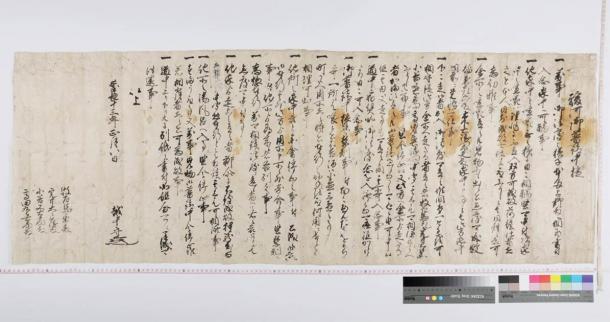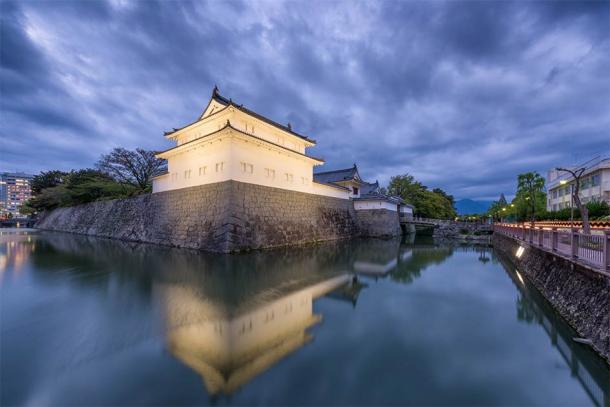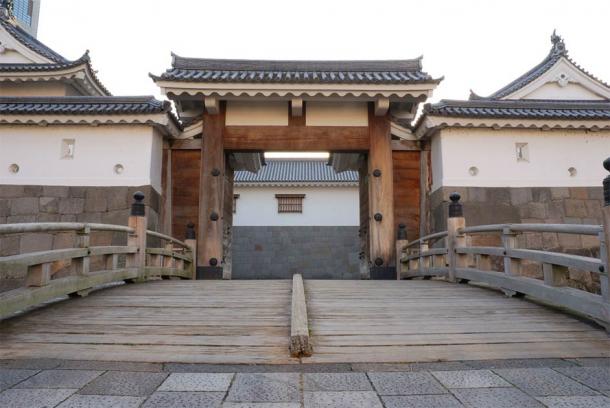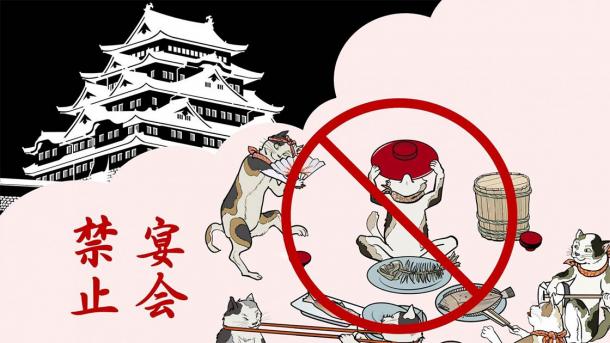Old letters can be a way to understand things that are still a mystery or as new historical evidence. A letter has been found that is from 17th century Edo Japan which is offering researchers new insights into Japan’s Edo period (1603-1868 AD) after a long period of civil wars. The letter records the code of conduct of vassals of a samurai lord during a national building project. This rare find is shedding light on how the Tokugawa shogunate was able to maintain peace and order in Edo Japan and into the lives of the samurai class in this period.

The letter from the lord of the Hosokawa clan detailing the articles to be followed when working with or meeting samurai from other clans in Edo Japan during a major reconstruction of Sunpu Castle. (Professor Tsuguharu Inaba / Kumamoto University )
The remarkable document was found by Professor Tsuguharu Inaba who is part of the Eiseibunko Research Center team at Kumamoto University. He discovered it among a collection held at the university. The document was issued by the head of the Hosokawa clan, Tadaoki Hosokawa, in 1608 AD. The Hosokawa were a powerful daimyo clan from the Kokura domain in what is now Kyushu. The letter stipulates how the vassals of the lord were to behave while engaged in the reconstruction of Sunpu Castle, located a little south-west of modern-day Tokyo (previously known as Edo).

Edo Japan Sunpu Castle as it looks today after extensive reconstruction and expansion in the early Edo period. ( Pixel_PEEP / Adobe Stock)
Rebuilding Sunpu Castle With Rival Samurai Clans
The rebuilding of Sunpu Castle was deemed to be of great strategic importance. Kumamoto University called it “a national project in the early Edo period.” The Japanese castle had been badly damaged by a fire in 1607 AD and the shogun, Ieyasu Tokugawa (1543-1616), ordered that the fortress be restored and also expanded. Tokugawa who was in effect the military ruler or shogun of Japan ordered three different major daimyo clans to participate in the project. According to Eurekalert, Sunpu Castle was “an important base for the Edo shogunate.”

The impressive east gate of Sunpu Castle, southwest of Tokyo, Japan. (Monado / CC BY-SA 2.5 )
This national project also had a political dimension. Eureka Alert reports that “It is commonly believed that these national projects prevented clans from accumulating wealth by forcing them to send out materials and men.” This in effect kept the regional daimyo lords weak and ensured that they did not establish semi-independent regional states, as in the past.
The Transition From Constant Civil War To Edo Prosperity
Eureka Alert quotes Professor Tsuguharu Inaba as saying that the letter “provides us with a great deal of information about the politics concerning feudal lord mobilization by the shogunate to build castles.” The shogun wanted to prevent any challengers to his rule and ensure that the regional feudal lords would not rebel. Japan in the early 17th century AD was just emerging from the highly unstable and warring state period known as the Sengoku period (1467-1615 AD).
In the recently discovered letter, the lord of the Hosokawa set down 13 articles that prescribed how his vassals had to conduct themselves. They were to obey the representative of the shogun in all things. Article two declares that anyone found fighting other clan members could be executed. The other articles sought to minimize the risk of conflict during the castle reconstruction project in various ways.
This was very important because the work on the castle was being carried out by three different clans. Indeed, at the Battle of Sekigahara (1600) the Hosokawa and the Mori clans, who both participated in the castle project, fought on opposite sites. Any fight or argument could “develop into a big conflict,” according to Kumamoto University . This in turn could have led to open conflict between daimyo clans, which could have destabilized the entire country.

Lord Hosokawa wrote a strict code of conduct to be observed by the Hosokawa clan. (Professor Tsuguharu Inaba/ Kumamoto University )
During The Castle Project: No Sake, No Sumo And No Fun!
Some of the articles in the letter provide fascinating insights into the “life of the soldier class (ashi-garu) mobilized for the project,” according to Eurekalert. This letter showed that they were tightly controlled by their lords and masters. They had to ask permission to visit the local town and could only drink three cups of sake. The vassals could only take hots baths with members of their clans. Sumo wrestling was forbidden, and even watching a wrestling match was a punishable offence. Fighting was strictly prohibited and those who engaged in it could be punished by death. Anything that could lead to conflict between clans or allowed members of different daimyo to come together to conspire was strictly prohibited.
These rules provide new insights into the years when Edo Japan transitioned from a civil war to a long period of peace and prosperity. Discipline was enforced to prevent the conspiracies and wars of the Sengoku period.
These draconian measures largely worked, and Japan entered a prolonged period of stability that came to an end in 1867 when American metal warships collapsed Edo Japan’s isolation from the outside world. Eurekalert reports that the letter “vividly conveys the aspects of the samurai society during its transition from a time of war to peace and prosperity.” Digitized images of the documents have been published on the Kumamoto University website.
Top image: The letter originated from Edo Japan and reveals how Lord Hosokawa wrote a strict code of conduct to be observed by the Hosokawa clan. (Professor Tsuguharu Inaba/ Kumamoto University )
By Ed Whelan
Related posts:
Views: 0
 RSS Feed
RSS Feed

















 November 20th, 2020
November 20th, 2020  Awake Goy
Awake Goy  Posted in
Posted in  Tags:
Tags: 
















